If you love mushrooms, have you ever been tempted to share your tasty fungi with your canine companion? They sit there and watch you eat, just begging to see what your joy is all about, so it’s only natural. The real question is, can dogs eat mushrooms?
Fortunately, for you and your dog, mushrooms you get at the store are perfectly safe for dogs to eat.
They are even be extremely nutritious!
But wild mushrooms are a different story. Some are totally fine, but others can be deadly to your pup… and yourself.
Are Mushrooms Good For Dogs?
Most people know that mushrooms are extremely healthy. They are on almost every superfood list ever written. But why?
They are jam packed with antioxidants, B vitamins, minerals, fiber, and so much more. They’re also low-calorie and low-fat. Just in case they needed to be even more beneficial.
This variety of nutrients will help your dogs immune system, digestion, skin, coat, nails, and even their brain. Some mushrooms also boast anti-inflammatory, anti-cancer, and anti-viral properties that can help your dog fight off infections and diseases.
Mushroom Supplements in Your Dogs Diet
Mushroom supplements are a great way to take advantage of all these health benefits!
Supplementing your dogs diet with mushrooms is pretty easy and straightforward as well. You can give them plain unseasoned mushrooms (cooked or raw), mushroom powders on their food, or capsules (if they’ll take them).
Most dogs will readily eat plain mushrooms, but of course some won’t. You’ll have to try a few different methods to see what works best for you and your dog. If you cook the mushrooms first make sure there is nothing added in that is harmful to your dog like onions.

Photo: Shutterstock
One of the best ways, in my opinion, is to grow your own mushrooms. You have better control over what goes on them like pesticides, unlike buying vegetables in the store. Plus it’s fun and rewarding to grow something.
FunGuy Grow Supply is a great resource for mushroom kits and growing guides to get you started in your fungi adventures.
You also get the added benefit of using certain medicinal mushroom species that may have additional health benefits like I mentioned above. Just a couple examples are:
- Turkey Tail Mushrooms: Known for its immune-boosting properties, turkey tail mushrooms can help strengthen your pet’s immune system and promote overall wellness. They contain polysaccharides and antioxidants that support a healthy response to inflammation.
- Maitake Mushrooms: These mushrooms have been used in traditional medicine for their potential anti-cancer properties. Maitake mushrooms may also assist in regulating blood sugar levels, promoting cardiovascular health, and supporting the immune system.
- Lion’s Mane Mushrooms: This unique mushroom provides unmatched brain function support in both humans and animals. Lion’s mane mushrooms may improve cognitive abilities and memory retention, making them an excellent choice for aging pets or those experiencing cognitive decline.
- Cordyceps Mushrooms: Cordyceps mushrooms are known for their energy-boosting effects. They can help increase stamina and endurance in active pets, making them ideal for working dogs or highly active cats.
Tips for Feeding Your Dog Mushrooms
When adding mushrooms to your dogs diet make sure you keep it under 10% of their daily intake. Moderation is key to most things and this is no different. While they provide tons of nutrients your dog needs, they don’t provide everything.
Also some dogs can be allergic to mushrooms. It’s rare but technically possible. When you introduce any new mushroom species be sure to only give a small amount at first and watch for an allergic reaction.
If your dog is allergic to mushrooms it will present typical allergy symptoms like:
- Coughing
- Sneezing
- Skin rash or hives
- Congestion
- Runny nose
Mushroom poisoning is very different and occurs if your dog eats a toxic mushroom.
Mushroom Poisoning in Dogs
Mushroom poisoning is the main risk of your dog eating mushrooms. Toxic mushrooms can damage their liver, kidneys, nervous system, or cause death.
A helpful tip to remember, if the mushroom is safe for you to eat, it’s safe for your puppy! There aren’t any mushrooms that are toxic to dogs but not us.
If your dog does happen to eat a toxic mushroom the severity of poisoning will depend on their size, the type of mushroom, and how much they ate.
Additionally some symptoms will appear within minutes to hours, or they can take days to weeks. It just depends on the specific type of mushroom.
Some common symptoms of mushroom poisoning in dogs are:
- Vomiting
- Diarrhea
- Abdominal pain
- Loss of appetite
- Lethargy
- Weakness
- Dehydration
- Jaundice
- Seizures
- Hallucinations
- Coma
If you think your dog ate a toxic mushroom, you should seek veterinary attention immediately. Do not induce vomiting unless instructed by your veterinarian.
If possible, bring a sample of the mushroom or a picture of it with you to the vet. The sooner your dog receives treatment, the better their chances of recovery.
Types of Toxic Mushrooms
There are thousands of different mushrooms in the world, roughly 11,000 in North America alone.
Most of them are perfectly safe to eat. Only a small percentage (3%) are poisonous. But some of the most toxic are also very common and widespread. They can even look very similar to the non-toxic ones.
Since it’s not feasible to list all the mushrooms that are safe for dogs to eat. Instead lets take a look at the 3 mushrooms most commonly responsible for poisoning in dogs.
Death Cap Mushroom (Amanita phalloides)
Found worldwide, the death cap mushroom is one of the most deadly mushrooms of all. It accounts for 90-95% of all fatal mushroom poisonings in dogs.
It contains 3 different toxins, the most harmful of which is alpha-amanitin. The combination of toxins causes severe or fatal liver failure.
Death cap mushrooms are often confused with other non-poisonous mushrooms like the paddy straw mushroom or the caesar’s mushroom.
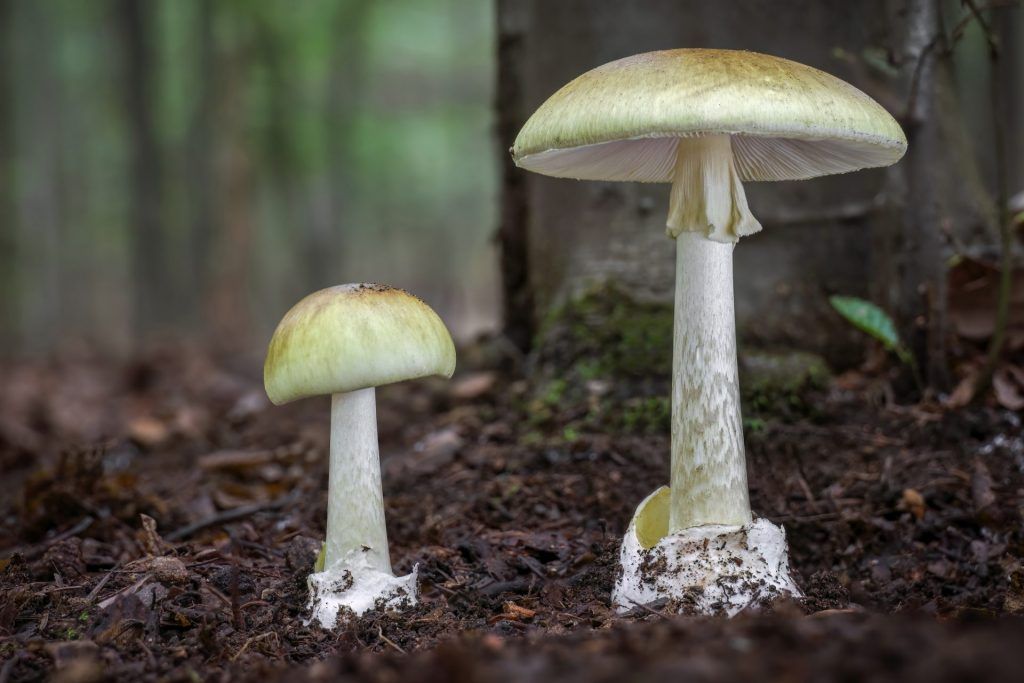
Photo: Shutterstock
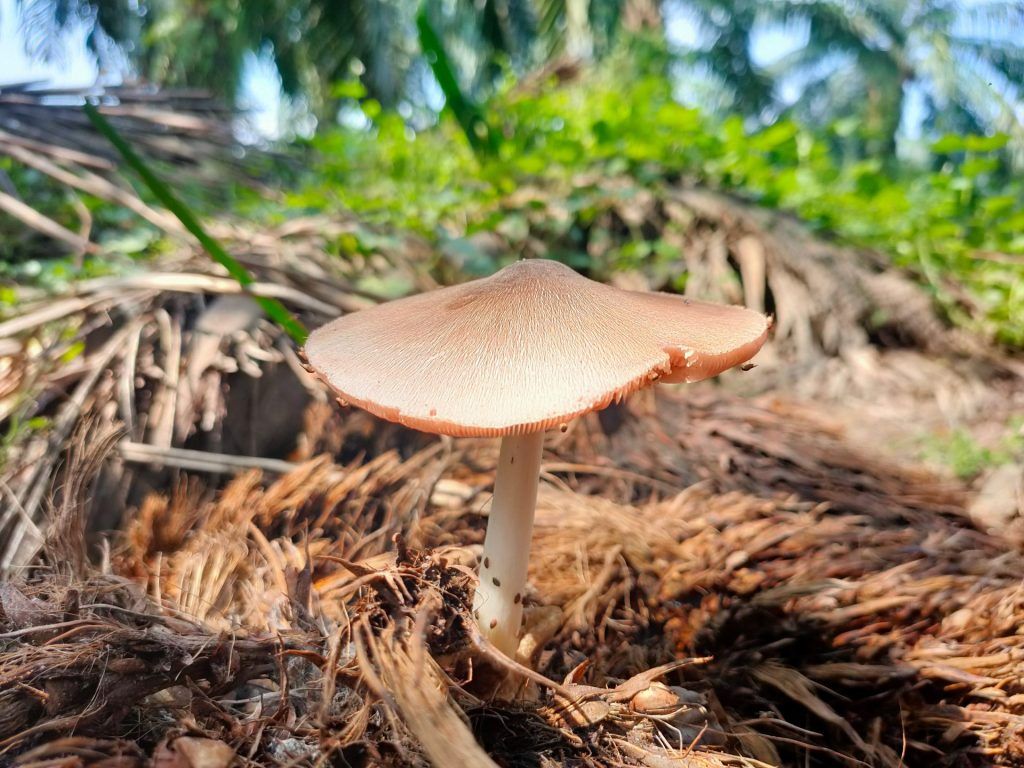
Photo: Shutterstock
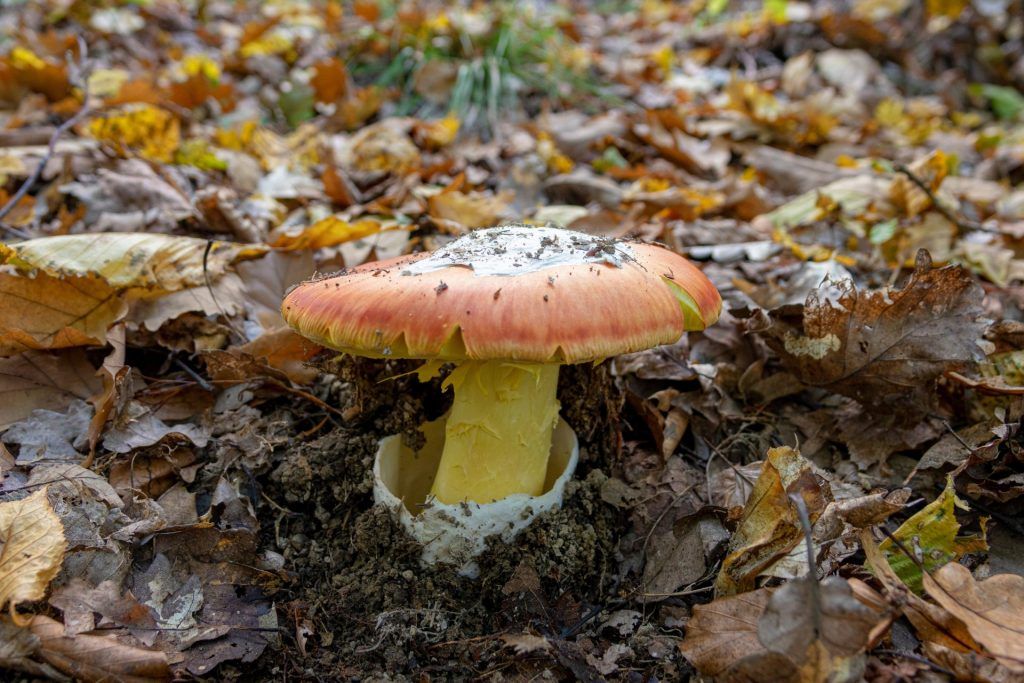
Photo: Shutterstock
The easiest way to avoid this mushroom is to know what it looks like. The death cap, or green death cap as it’s also called, mushroom has a white to yellow-green cap that is usually smooth but can be slightly scaly. It also has white gills, a white stem, and a large sac-like structure called a volva at the base.
Sometimes the volva of the death cap is underground and you have to dig up the whole mushroom to see if it’s there or not.
They are often found growing around certain trees like oaks and pines.
A death cap mushroom is so deadly that just a tiny bite can kill your dog. It can kill you as well if you eat one by mistake, but most likely it will take more than a single small bite. The toxic properties of this mushroom are so strong that it can destroy liver cells within hours. And up until just a couple months ago, there was no chance of an antidote.
Indocyanine green, a dye already used in various medical procedures, stopped the poison from death cap mushrooms in tests with mice and human cells. There are a lot of tests left to do, and likely won’t be tested and approved for dogs for a while. But potentially there is an antidote on the horizon.
If your dog does find and eat this mushroom, they will typically start showing symptoms within 6 to 24 hours after ingestion, sometimes earlier. They will vomit, have diarrhea, lose their appetite, become lethargic, and have severe abdominal pain. They can also develop jaundice (yellowing of the skin and eyes), bleeding disorders, and seizures. If they aren’t treated in time, they will go into a coma and die from liver failure. Even with treatment they can suffer long term complications or death.
So keep your dogs away!
Galerina Marginata (Galerina autumnalis)
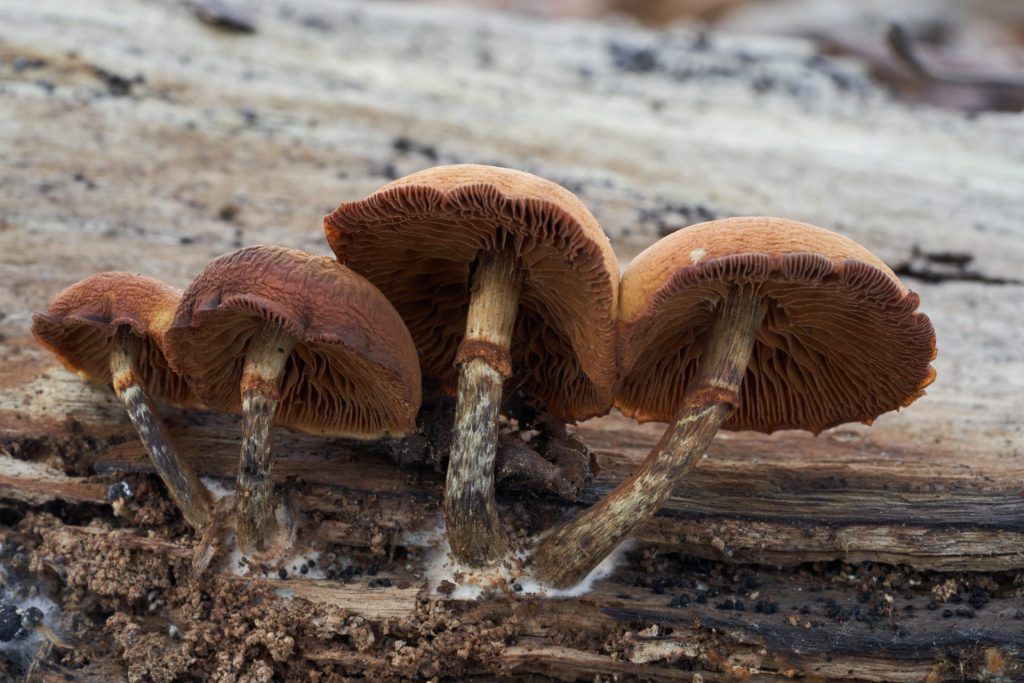
Photo: Shutterstock
Galerina marginata, also known as funeral bell or deadly galerina, is another highly toxic mushroom containing alpha-amanitin. It causes similar symptoms and effects as the death cap mushroom.
The galerina marginata has a smooth or slightly scaly brown to yellow-brown cap. The stem is brown with brown gills and a thin ring that can disappear with age. They are most commonly found growing on decaying wood.
The honey fungus or oyster mushrooms are edible mushrooms that the galerina marginata is sometimes mistaken for. These edible mushrooms have white gills and spore prints that help differentiate them.
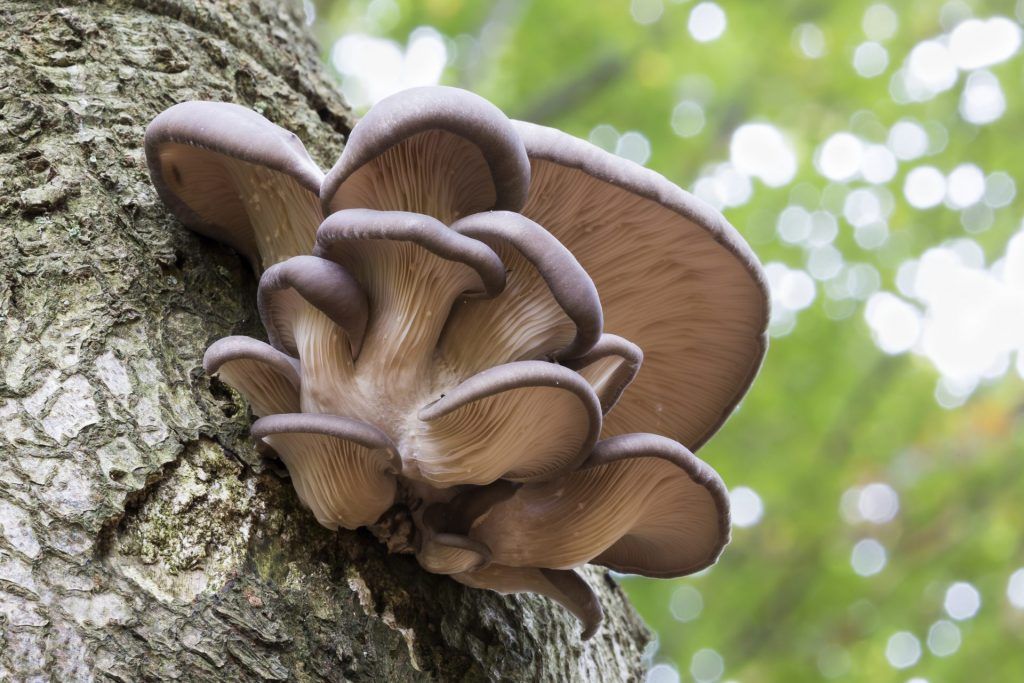
Photo: Shutterstock

Photo: Shutterstock
Just like the death cap mushroom, the galerina marginata is also very dangerous for your dog. It causes the same symptoms and damage as the death cap mushroom.
Fly Agaric (Amanita muscaria)
The fly agaric is a well-known mushroom with psychoactive properties. It contains ibotenic acid and muscimol, which are toxins that affect the nervous system. These toxins cause hallucinations, confusion, agitation, and seizures. The fly agaric is known to cause gastrointestinal upset, dehydration, and kidney damage as well.
Being quite possibly the most iconic mushroom in the world, often used in fairy tales and pop culture, the fly agaric has a very noticeable appearance. Remember Alice in Wonderland? This is the mushroom responsible for her trip down the rabbit hole. It’s the one with a bright red or orange cap covered in white spots.

Photo: Shutterstock
They also have white gills (not attached to the stem), a white stem with a ring, and a volva at the base like the death cap. They’re commonly found growing around birch and pine trees.
Even though it’s toxic, there are actually many cultures that eat these mushrooms. Properly prepared of course! But if it’s raw or you don’t know what you’re doing it’s best to stay away.
Fun Fact:
Berserker Vikings are believed to have eaten fly agaric mushrooms, raw of course, as part of a ritual before battle. It’s said this is what gave them their strength, rage, and fearlessness that led to winning many battles. This is a hotly contested theory but to me it sounds logical, and would come as no surprise.
For an unknown reason, cats, dogs, and other animals like reindeer seem to be strongly attracted to fly agaric mushrooms. In the case of dogs they are very dangerous and can potentially cause death.
Symptoms usually appear within 30 minutes to 2 hours after eating. Your dog may vomit, have diarrhea, drool excessively, become restless, behave strangely, or have muscle tremors. They can also experience hallucinations, confusion, agitation, and seizures.
In severe cases, they may develop kidney failure or fall into a coma followed by death.
Fortunately, the prognosis for dogs that ate a fly agaric mushroom is actually pretty good if they receive prompt treatment.
How to Prevent Mushroom Poisoning in Dogs
Most often, dogs get into poisonous mushrooms when wandering outside, even at the dog park, so it can be difficult to prevent. The best thing you can do is monitor them when they are outside and if you notice mushrooms in the area keep your dog away. At least until you are able to identify that they are safe mushrooms.
If you want to feed your dog mushrooms, great! Like I mentioned before they are super healthy. But stick to either store bought mushrooms or ones from a trusted source.
If you are hunting mushrooms you might want to take your dog with you. Many dog breeds can be trained to hunt mushrooms. Breeds like the Lagotto Romagnolo and German Shepherd are actually quite skilled at this.
But remember to watch your dog closely, even though they are well trained at finding certain mushrooms, they are often not very good at leaving them alone. Which can result in your prized truffles being a tasty snack (not for you!) or an emergency trip to the vet.
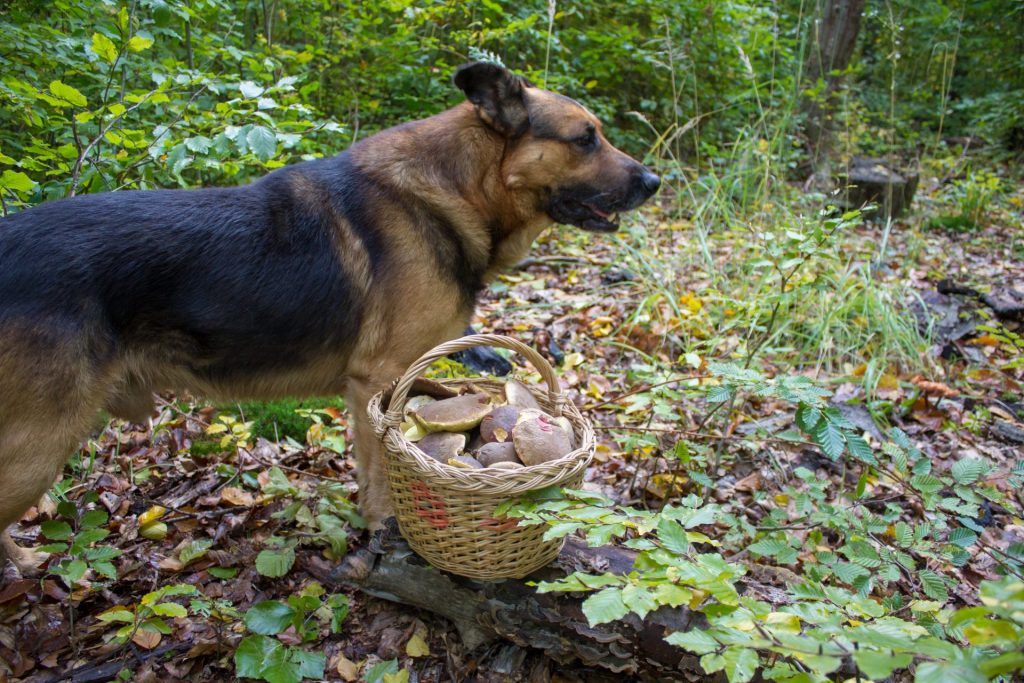
What to Do If Your Dog Eats a Wild Mushroom
If your dog eats a mushroom that you aren’t sure about, try not to panic. Well, maybe panic a little, but keep your cool.
The first step is identification. If possible, take a picture of the mushroom your dog ate or collect a sample.
If you still don’t know if the mushroom was safe or not the next step is to watch your dog for any symptoms of mushroom poisoning.
If your dog starts to show any signs of distress, like vomiting, diarrhea, weakness, or seizures, call your veterinarian immediately. Tell them what kind of mushroom your dog ate (if you know) and how much they ate. Follow their instructions on what to do next.
If you can’t get ahold of your vet, call the Animal Poison Control Center at 1-888-426-4435. They are open 24 hours a day and can provide you with expert advice on how to handle the situation. I believe there is usually a fee for this service.
Do not try to treat your dog with at home remedies, contact a vet!
























